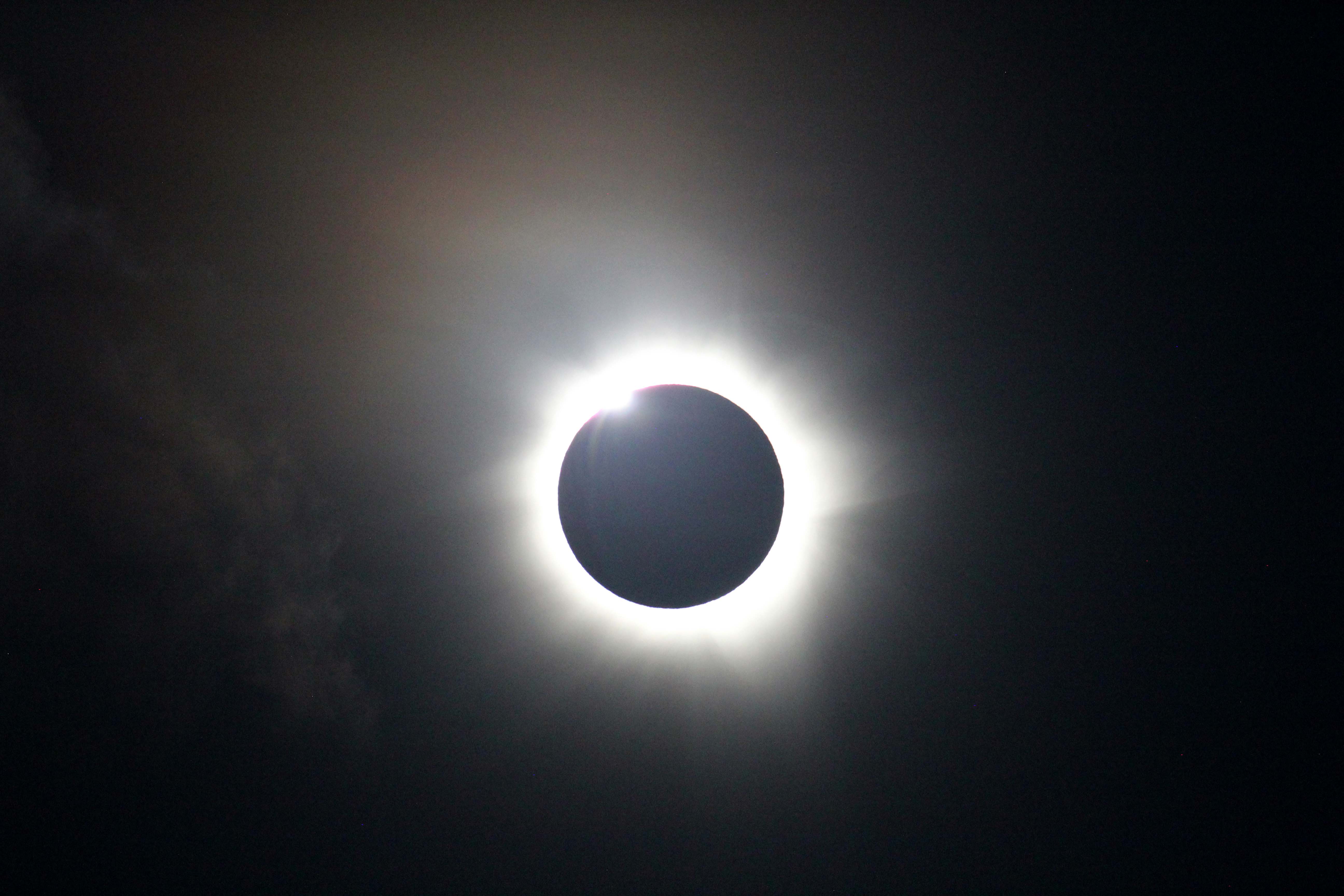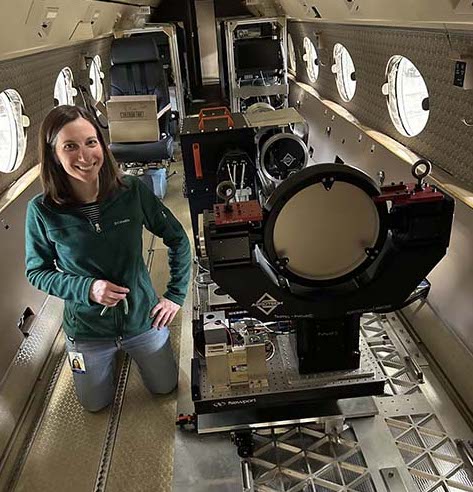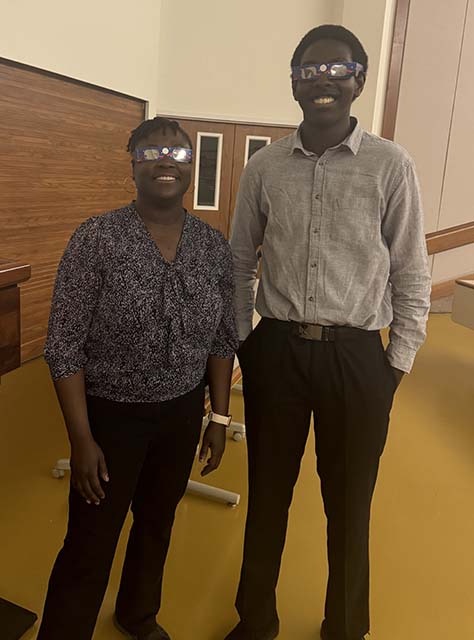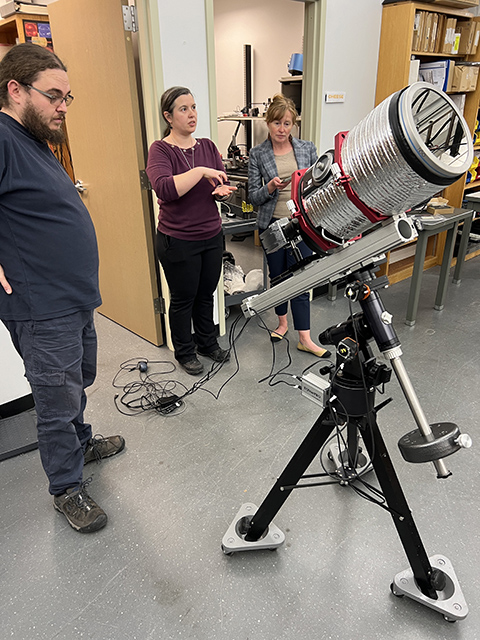Total eclipse: celestial wonder and scientific opportunity
NSF NCAR scientists prepare to use natural phenomenon to study the Sun and inspire love of science
Mar 25, 2024 - by Audrey Merket
Mar 25, 2024 - by Audrey Merket

Solar eclipse over Australia. (©UCAR. Image: Lance Jones. This image is freely available for media and nonprofit use.)
As the April 8, 2024 total eclipse approaches, scientists and staff with the U.S. National Science Foundation National Center for Atmospheric Research (NSF NCAR) are preparing a variety of experiments and outreach projects to further our knowledge of the Sun and engage various communities in observing and understanding this extraordinary and rare event.
The Sun’s atmosphere is almost impossible to observe on a regular day because the surface is a million times brighter and overpowers the dimmer light of the atmosphere. During a total solar eclipse, however, Earth’s moon blocks out all the brightness and makes it possible to observe the Sun’s upper atmosphere, or corona. This produces not only a breathtaking natural phenomenon, but also ideal conditions for learning about our nearest star.
While extremely difficult to view and study, a better scientific understanding of the solar corona is important for life on Earth. In our technologically dependent society, understanding the corona helps improve our ability to predict dangerous space weather that can interfere with radio communications or take down the electric grid.

Traveling at more than 500 miles per hour, NSF NCAR’s Gulfstream V (GV) jet will take to the skies to chase the eclipse and collect data that will shed light on some of the scientific mysteries of the Sun’s corona. Onboard the GV, the Airborne Coronal Emission Surveyor (ACES) instrument will look at the infrared light emitted by the corona.
ACES is not just taking pictures of the eclipse, but looking for light emitted at specific wavelengths using a spectrometer. By measuring the intensity at a particular wavelength, scientists can decode properties like the temperature of the Sun’s plasma or the density of the corona.
The primary reason for utilizing NSF NCAR’s GV is to improve viewing conditions by getting above most of the infrared-absorbing gasses in Earth's atmosphere. The GV will fly at an altitude of 45,000 feet, about 10,000 feet above commercial airliners. Chasing the eclipse in this way also has the advantage of extending the observation period by about 50%.
“It’s like trying to take a picture of a dark scene at night; you need a longer exposure to produce less grainy images. The extra time allows the instrument to build up sensitivity and help us get clearer observations,” said Jenna Samra, Smithsonian Astrophysical Observatory scientist and ACES principal investigator.
Spanning the path of totality in the U.S. from Texas to Maine, 35 non-professional scientist teams will participate in the Citizen Continental-America Telescope Eclipse (CATE) project. Each CATE site will use identical equipment to collect the same type of data. Teams will view the eclipse in totality for about four minutes, but when the images are stitched together, they will provide a total of 60 continuous minutes of totality observations. The resulting footage will allow scientists to see how the Sun’s corona dynamically changes during the eclipse.
NSF NCAR is a major partner in this program, which is jointly funded by NSF and NASA. A previous CATE campaign in 2017 used telescopes that took only images of the eclipse. This year’s campaign utilizes a different camera that measures the polarization of light. This improvement in observation will provide more information about the structure of the corona, such as its density, which will help scientists better understand plasma properties of the Sun.
“It is really powerful to get people involved in collecting data. These teams are participating in real science, not just watching the eclipse,” said Paul Bryans, NSF NCAR scientist and CATE co-investigator.
CATE aims to engage individuals or communities that haven’t seen an eclipse before. Participants are trained in how to use the equipment prior to the eclipse. Afterward, the equipment stays in the community as a free resource that can be used for other experiments or educational purposes. Teams come in many different forms, such as community clubs, school groups, or multigenerational families. NSF NCAR’s Education, Engagement, & Early-Career Development team and local filmmakers will co-produce a documentary about CATE.

An NSF NCAR internally funded project aims to expand the science and wonder of eclipses to colleges and universities outside the reach of larger eclipse education efforts. In March and early April, NSF NCAR scientists will visit several schools within a day's drive of the path of totality, with a focus on minority serving institutions and historically black colleges and universities. Scientists will spend two days at each school providing seminars about the eclipse, introducing ways to get involved — like community science projects or NASA’s eclipse megamovie — and performing science demonstrations.
“We hope that these visits will be the start of a relationship between NSF NCAR and schools that don’t have geoscience or astronomy programs, as well as encourage interest in these fields,” said Samaiyah Farid, NSF NCAR scientist.
In New York, NSF NCAR will deploy three micropulse differential absorption lidars (MPDs) in collaboration with the New York State Mesonet. The MPDs will allow scientists and students to observe changes in atmospheric water vapor and temperature vertical profiles before, during, and after the eclipse, which can cause an extremely abrupt change to the weather as the Sun’s heat and light are temporarily blocked.
Two of the MPDs will be in the direct path of the eclipse, and the third will be in Albany, which will experience about 97% totality.
This NSF grant-funded field project with the University of Albany will happen in conjunction with the NASA Nationwide Eclipse Ballooning Project, in which students from multiple universities along the U.S. eclipse path will launch radiosondes before, during, and after the eclipse.
“Not only are total solar eclipses a rare life-altering experience, but they provide an ideal laboratory to inspire, teach, train, and equip undergraduate students on planning and conducting scientific field campaigns, learning about and operating the state-of-art profiling technology, and performing subsequent scientific data analysis,” said Tammy Weckwerth, NSF NCAR scientist and co-principal investigator of the project.
NSF NCAR scientists are also participating in several ground-based experiments related to the eclipse. In the case of the Coronal HElium Emission Spectrograph Experiment (CHEESE), Momchil Molnar, a postdoctoral fellow, is building a special telescope to test a measurement that has been widely disputed in solar science for almost three decades.
With the help of his mentor, Roberto Casini, Molnar built a near infrared spectrograph that will try to observe an infrared spectral line of neutral helium in the solar corona during the eclipse. The CHEESE instrument is very similar in design to the one used in the original experiment in the 1990s but with more advanced components, such as a better camera.
“You have four minutes to do a very complex experiment, but the outcome is actually quite clear. Either you detect the line or not,” said Molnar.

Another field telescope experiment, FeSun, will measure the infrared emission of iron in order to map the density of the plasma in the Sun’s corona. The experiment, which is a joint effort of the NSF’s AURA National Solar Observatory (NSO) and NCAR, will capture the entire Sun’s corona in infrared. In order to do this, the FeSun telescope will capture four images, one in each quadrant of the solar disk, that will be brought together like a mosaic to give a complete picture of the Sun. The data collected will help to validate current calculations of the coronal densities.
“Even though we are imaging the Sun, we are actually light-starved.” said Alin Paraschiv, NSO scientist.
“That’s because the light we are interested in is infrared, and most of those emissions are invisible to the naked eye,” added Daniela Lacatus, NSF NCAR scientist.
The execution of the experiment the day of the eclipse is fairly simple, but to get to that point two months of intense preparations and tests are required to get the setup just right. Two days before the eclipse when the instrument arrives in Texas, scientists will align the telescope with the North Star, check to make sure it is tracking correctly, and make adjustments as needed. When totality arrives, all they need to do is press a button.
A website put together by NSF NCAR scientists utilizing NASA funding is a great resource for the scientific community of experiments happening at NSF NCAR and beyond. The WHPI Eclipse Campaign page aims to collect the details of all eclipse efforts in a single location and is a useful source for cross-disciplinary collaborations. Any experiment, no matter how simple, is welcome and can be submitted on the website.
For science enthusiasts who are local to Boulder, Colorado, the UCAR Center for Science Education will be hosting a solar eclipse viewing at the historic Mesa Lab. Boulder will experience about 70% coverage of the Sun. The event will feature free hands-on activities and solar viewing opportunities for all ages.